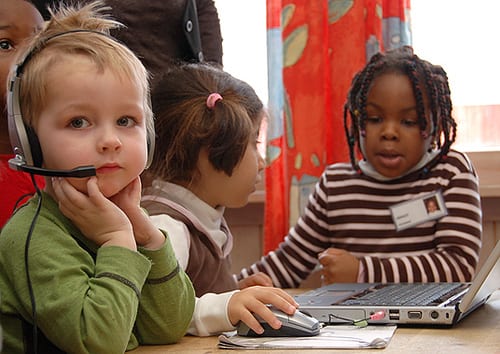When we think about the future of consumerism, and postconsumerism, we think a lot about what the upcoming generations are being taught and how that may or may not impact the grip of addictive consumerism on the nation. The relationship that the current generation has with digital life may be a benefit or a drawback; it’s too soon to say. But it’s certainly worth a thought piece examining how the digital native generation may have healthier views on consumerism – or may not.
But, You Say, What is a Digital Native?
Have you interacted with a preschooler or even a child as young as a toddler recently? One thing that you may have noticed if you did was that they seem to intuitively know how to use touch screens on tablets and smartphones. In fact, we know some toddlers in real life who can already maneuver a touchscreen but are confused by a laptop keyboard. For this generation of children, unlike most of the generations before them, this type of technology has always been in their lives and they grow up with a natural and organic sense of it. Think about it. For a forty-year old person right now, VCRs and laptops and the internet all were invented within their lifetime. No matter how much they use that technology, there’s always a sense of it being foreign to them. The current generations are referred to as Digital Natives for that reason.
Just for a little history (because it’s interesting), the term Digital Natives was coined by Marc R. Prensky, an education consultant. His theory, which is elaborated on in his book, is that one of the core problems with contemporary education follows that children born after 1980 are Digital Natives, but they are being taught by a generation of Digital Immigrants. Therefore, the teachers can never really truly understand the needs and learning patterns of the children. It’s a bit unrelated to what we’re talking about, but we think that it’s fascinating history nonetheless.
How Will Digital Natives View “Stuff?”
That’s the big question, isn’t it? This generation will grow up with as much interest in “digital stuff” as in physical stuff. That may or may not be healthier. After all, you can experience the same type of emotional displacement with virtual stuff as you can with physical stuff. There are plenty of actual cases of hoarding in The Sims. That said, there may be a benefit from the move towards digital capital and digital “stuff.” Obviously, online transactions can transpire without full capital. Bartering and trading is more common. As power (may) shift away from consumer dollars, it may shut down the mass production and creation of consumer marketing infrastructures.
There’s also the more obvious benefit. If Digital Natives ultimately grow up to put a higher premium on digital “stuff” than they do physical “stuff,” there is certainly an opportunity to treat the planet more kindly. We don’t need to tell you how much carbon footprint is created to support the mass addictive consumer needs of contemporary society. Less physical stuff may not solve the mental and emotional (or possibly even the economic) problems of mass consumerism, but it can ultimately help to heal the earth.
Of Course, Digital Stuff Needs Digital Mediums
Don’t rush to get too excited, though. There’s also the possibility that this could go the other way. We’ve already seen the mass consumer hysteria (yes, we’re choosing that word with intention) that can happen around a new smartphone, tablet and now wearable piece of technology. And we’ve previously discussed how much the tech industry relies on the economics of upgrade marketing. It’s also no global secret that much of the manufacturing of those endless electronics and their upgrades results in serious pollution as well as no shortage of human rights issues. So while the Digital Native generation may love virtual “stuff,” they need physical “stuff” to operate it on. That may just shift the types of products that make up the core of society’s consumer addiction.
Or, You Never Know. The Change May Not Be Because of Technology.
It seems impossible in this day and age to not speculate how technology and our increasing relationship with it will impact the future, but there’s a very real possibility that the relationship of Digital Natives to technology will have nothing to do with the postconsumer shift that we truly believe will happen. Perhaps this generation of children will simply learn from the mistakes of previous generations and look to find happiness and satisfaction in ways that don’t involve “stuff.” As stewards of the next generation, we can all help to make that change happen by teaching postconsumer lessons early. In fact, our desire to help do that is why we created our entire Postconsumer Parenting collection of articles.
No matter what happens, there are likely two things that we can all agree on. Firstly, the world that children born after 1980 will live in is entirely different from the one experienced by their predecessors. Secondly, we hope that it’s a better world and that part of how they make it that way is by understanding the role and limitations of materialism as a societal backbone.
Did we miss a way in which digital natives may or may not change the relationship with addictive consumerism? If so, tell us about it on the social media channels below.
Facebook | Twitter | Instagram | Tumblr | Pinterest | Google+ | Medium
Photo Credit: Juan Cristóbal Cobo via Flickr




